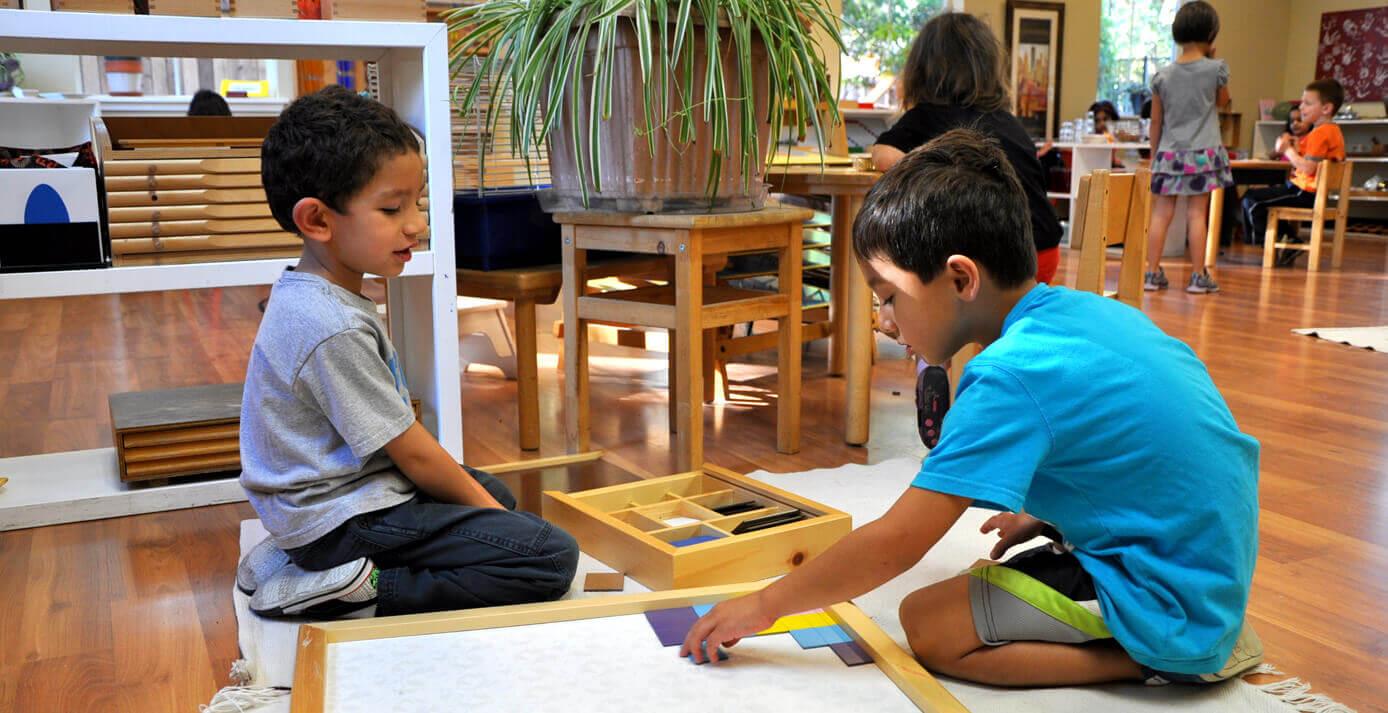The Influence of the Montessori Method Today

Maria Montessori is the creator of a teaching method that revolutionized the field of early education. Such was the scope of its proposals that its name transcended its field. The method she proposed put special emphasis on games, which made it the perfect medium to develop multiple skills and abilities in children.
Many nursery schools provide an excellent example of this method. We speak of non-compulsory education that focuses on playing, fun, and flexibility. It allows children to be spontaneous and have initiative. Ultimately, Maria Montessori’s method favors the independence of the youngest children. At the same time, it helps them acquire the basic values of coexistence, cooperation, and respect.
The Montessori method at present would encourage the natural development of skills in the youngest children based on exploration, collaboration with companions, curiosity, play, and communication.
The basic principles of the Montessori method
We can analyze the basic principles that govern the Montessori method today. Although its implementation can lead to different adaptations depending on the preferences of the educators, we’ll explain its essence below.
To begin, the Montessori method encourages discovery-based learning. We all have an innate curiosity. Montessori instructors believe children learn better if something awakens this natural curiosity so they want to learn more and make their own discoveries. This method takes advantage of this natural inclination that children have to ask questions and find answers.

Also, followers of this method believe that the environment must meet each child’s needs according to their characteristics (age, culture, a diagnosis such as autism, etc.). We must also add adapting the method to the natural material with which each child can interact and play. Here we are referring to wood, dirt, and other natural materials.
All the games the instructor uses must have a collaborative component. The teacher must supervise, direct, and coordinate these games. However, the teacher must intervene as little as possible when it comes to the learning process. They must try to merely guide the students in their learning.
The Montessori method seeks to turn traditional education around. Its goal is to transform classes into dynamic and fun experiences. For this reason, classes last about 3 straight hours, without any interruption.
To finish our discussion about the principles of this method, we must point out that the Montessori method seeks to divide classes into age groups, rather than grade levels (with a maximum age difference of three years). For example, children between 6 and 9 would be together in one classroom. This way, they interact with a variety of ages. This is a very beneficial stimulus.
The Montessori method today
Fortunately, the Montessori method has survived the passage of time. It’s still used in different schools. It favors games and the independence and autonomy of children, as well as interaction with diverse elements to awaken curiosity. In short, it reaps children’s natural inclination towards games and fun, turning it into the main educational engine.
However, as we immerse ourselves in conventional primary education, the panorama changes. Children spend hours paying attention to their teachers, being rewarded for not talking (or punished for doing so), unable to talk, and having to pay attention for long periods of time. One class comes before the other. This specializes in taking away any intrinsic motivation for learning.

There are several schools that have chosen the Montessori method. In spite of all this, there’s still doubt. Is the Montessori method only for children between the ages of 0 and 6 years? Although most schools currently offer this method only to this age group, the fact is that Maria Montessori designed it so that it could be used until the age of 12.
However, the Montessori method could also be applied at the high school level. Maria Montessori, although she didn’t have time to design and develop it completely for this stage, did leave some established guidelines on the steps to take with older children.
The current education system focuses a lot on grades. For that reason, a lot of pressure is put on students to complete tasks that will lead to a favorable final grade. The Montessori method seeks the opposite. There are no exams nor homework because the main objective is to learn, not get the best grade.
The data tells us that the education that takes place after primary school bores students. Far from motivating them, it makes them think going to school is useless. This situation should be an incentive to rethink the way we teach. Currently, competitiveness is fostered. Grades label students as unsuccessful or intelligent. However, the primary objective is that students should feel motivated to understand the world around them.

Maria Montessori is the creator of a teaching method that revolutionized the field of early education. Such was the scope of its proposals that its name transcended its field. The method she proposed put special emphasis on games, which made it the perfect medium to develop multiple skills and abilities in children.
Many nursery schools provide an excellent example of this method. We speak of non-compulsory education that focuses on playing, fun, and flexibility. It allows children to be spontaneous and have initiative. Ultimately, Maria Montessori’s method favors the independence of the youngest children. At the same time, it helps them acquire the basic values of coexistence, cooperation, and respect.
The Montessori method at present would encourage the natural development of skills in the youngest children based on exploration, collaboration with companions, curiosity, play, and communication.
The basic principles of the Montessori method
We can analyze the basic principles that govern the Montessori method today. Although its implementation can lead to different adaptations depending on the preferences of the educators, we’ll explain its essence below.
To begin, the Montessori method encourages discovery-based learning. We all have an innate curiosity. Montessori instructors believe children learn better if something awakens this natural curiosity so they want to learn more and make their own discoveries. This method takes advantage of this natural inclination that children have to ask questions and find answers.

Also, followers of this method believe that the environment must meet each child’s needs according to their characteristics (age, culture, a diagnosis such as autism, etc.). We must also add adapting the method to the natural material with which each child can interact and play. Here we are referring to wood, dirt, and other natural materials.
All the games the instructor uses must have a collaborative component. The teacher must supervise, direct, and coordinate these games. However, the teacher must intervene as little as possible when it comes to the learning process. They must try to merely guide the students in their learning.
The Montessori method seeks to turn traditional education around. Its goal is to transform classes into dynamic and fun experiences. For this reason, classes last about 3 straight hours, without any interruption.
To finish our discussion about the principles of this method, we must point out that the Montessori method seeks to divide classes into age groups, rather than grade levels (with a maximum age difference of three years). For example, children between 6 and 9 would be together in one classroom. This way, they interact with a variety of ages. This is a very beneficial stimulus.
The Montessori method today
Fortunately, the Montessori method has survived the passage of time. It’s still used in different schools. It favors games and the independence and autonomy of children, as well as interaction with diverse elements to awaken curiosity. In short, it reaps children’s natural inclination towards games and fun, turning it into the main educational engine.
However, as we immerse ourselves in conventional primary education, the panorama changes. Children spend hours paying attention to their teachers, being rewarded for not talking (or punished for doing so), unable to talk, and having to pay attention for long periods of time. One class comes before the other. This specializes in taking away any intrinsic motivation for learning.

There are several schools that have chosen the Montessori method. In spite of all this, there’s still doubt. Is the Montessori method only for children between the ages of 0 and 6 years? Although most schools currently offer this method only to this age group, the fact is that Maria Montessori designed it so that it could be used until the age of 12.
However, the Montessori method could also be applied at the high school level. Maria Montessori, although she didn’t have time to design and develop it completely for this stage, did leave some established guidelines on the steps to take with older children.
The current education system focuses a lot on grades. For that reason, a lot of pressure is put on students to complete tasks that will lead to a favorable final grade. The Montessori method seeks the opposite. There are no exams nor homework because the main objective is to learn, not get the best grade.
The data tells us that the education that takes place after primary school bores students. Far from motivating them, it makes them think going to school is useless. This situation should be an incentive to rethink the way we teach. Currently, competitiveness is fostered. Grades label students as unsuccessful or intelligent. However, the primary objective is that students should feel motivated to understand the world around them.

This text is provided for informational purposes only and does not replace consultation with a professional. If in doubt, consult your specialist.







